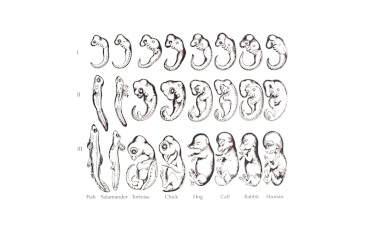A Lingering Myth of Evolution
Romans 1:21-22
“Because that, when they knew God, they glorified him not as God, neither were thankful; but became vain in their imaginations, and their foolish heart was darkened. Professing themselves to be wise, they became fools…”
 Ernst Haeckel is famous for having produced diagrams of embryos, to show their similarity. His idea was that “ontogeny recapitulates phylogeny”. In other words, the developmental stages, through which an embryo goes (ontogeny), are a sort of recapitulation of the evolution of that organism (phylogeny). I clearly remember being taught this, as an evidence of evolution, when I was in elementary school. As I remember which teacher taught this, I know that I must have learned this in 1971.
Ernst Haeckel is famous for having produced diagrams of embryos, to show their similarity. His idea was that “ontogeny recapitulates phylogeny”. In other words, the developmental stages, through which an embryo goes (ontogeny), are a sort of recapitulation of the evolution of that organism (phylogeny). I clearly remember being taught this, as an evidence of evolution, when I was in elementary school. As I remember which teacher taught this, I know that I must have learned this in 1971.
Haeckel’s famous drawings were published in 1874, but almost immediately criticized. Haeckel’s theory has been known to be false since at least 1965. His drawings were not just an error. The drawings were deliberately shaped, to support his recapitulation theory, even though the actual shapes of the embryos did not show such similarities. Yet, when I became a schoolteacher in 1983, teaching at a government school in England, I was handed a science curriculum, which included this very concept, twenty years after it had been shown to be false, and twelve years after I had been taught it.
In my office, I have a copy of a number of high school science textbooks. One of the best known Biology textbooks is that published by Prentice Hall. My edition was published in 2002, nearly forty years after Haeckel’s ideas were debunked. Yet, this book includes that concept as one of the main evidences for Darwinian evolution. One is forced to conclude that evolutionists mislead themselves, because they desperately want evidence for their ideas, and the evidence is simply not there.
Prayer: Lord God, You have shown us in Your word that You made everything from nothing, in just six days, and that it was all very good. Thank You that all of creation points to You, and in that creation, Your invisible attributes are clearly seen.
Author: Paul F. Taylor
Ref: Simpson, G.G. and Beck, W. (1965), An Introduction to Biology (New York: Harcourt Brace and World), p. 241. Miller, K. and Levine, J. (2002), Biology, (Needham, Massachusetts: Prentice Hall), p. 385. Image: G.J. Romanes (1892), Public Domain (due to age).
© 2022 Creation Moments. All rights reserved.